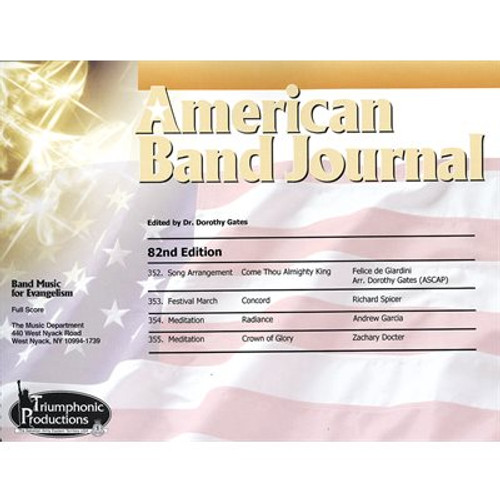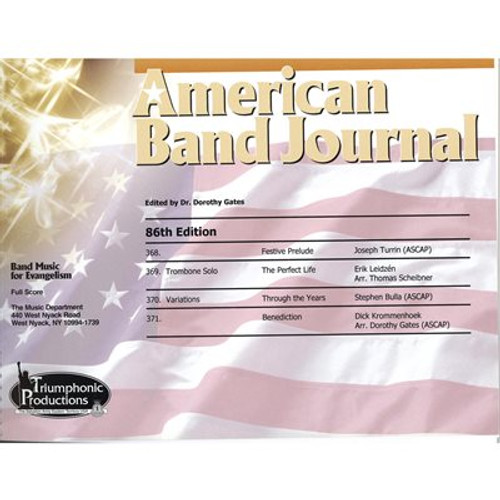Product Description
Band Music for Evangelism
Edited by Dr. Dorothy Gates
PrefaceSeasoned composers have contributed to this issue of the American Band Journal. Conductors will find a useful variety of music for worship and concert settings.
James Curnow's march "Boundless Army" is very approachable and has a feel of Americana. Andrew Mackereth's march "Joyful Intercessors" is a Salvation Army style march through and through, with great evangelical appeal, featuring the old marching song "Whosoever Heareth."
The other items are more contemplative in nature. Roger Trigg's transcription of the "The Prayer" will not only be recognizable by the general public but will work in almost any setting. David Catherwood's beautiful cornet solo based on "Amazing Grace" will also find a home in many programs.
Rounding out this issue is Douglas Court's Meditation "O Live Thy Life in Me." This meditative music will have special meaning to Salvationists but will be appreciated by any audience. Enjoy the music. Be blessed!
Ronald Waiksnoris
Territorial Music Secretary
| # | Genre | Title | Composer/arranger | Preview |
|---|---|---|---|---|
| 327 | March | Boundless Army | James Curnow (ASCAP) | Score |
| 328 | Cornet Solo | How Sweet the Sound | American Melody, arr. David Catherwood | Score |
| 329 | Hymn Tune Arrangement | O Live Thy Life in Me! | Harry Anderson, arr. Douglas Court (ASCAP) | Score |
| 330 | The Prayer | David Foster & Carole Bayer Sager, arr. Roger Trigg | Score | |
| 331 | March | Joyful Intercessors | Andrew Mackereth | Score |
Instrumentation
Each package contains the following:
* indicates part is optionalTransposed parts in F and C (treble clef and bassclef) are available at no cost from the publisher forABJ 36 on.
Adapting the American Band Journal for Concert Band or Orchestra
The following instrument/part correlation chart will be a helpfulguide to those directors who are using the American Band Journalwith concert band or orchestra:
| Full Score | 1 |
| Soloist's Part | 1 |
| E? Soprano Cornet * | 1 |
| B? Cornet 1 | 6 |
| B? Cornet 2 | 3 |
| B? Flugel Horn * | 1 |
| E? Horn 1 | 2 |
| E? Horn 2 | 2 |
| B? Baritone * | 2 |
| B? Trombone 1 | 2 |
| B? Trombone 2 | 2 |
| Bass Trombone * | 1 |
| B? Euphonium | 2 |
| E? Bass | 2 |
| B? Bass | 2 |
| Percussion 1* | 2 |
| Percussion 2* | 1 |
Adapting the American Band Journal for Concert Band or Orchestra
The following instrument/part correlation chart will be a helpfulguide to those directors who are using the American Band Journalwith concert band or orchestra:
| Flute | play C Instrument 1 upper octave |
| Oboe | play C Instrument 1 lower octave |
| English Horn | play F Horn 1 or 2 |
| Bassoon | play Baritone B.C., Euphonium B.C. or Tuba B.C. |
| E? Soprano Clarinet | play E? Soprano Cornet |
| 1st B? Clarinet | play B? Cornet 1 |
| 2nd & 3rd Clarinet | play B? Cornet 2 |
| E? Alto Clarinet | play E? Horn 2 |
| B? Bass Clarinet | play B? Tuba T.C. |
| E? Contra Alto Clarinet | play E? Tuba |
| B? Contra Bass Clarinet | B? Tuba |
| 1st E? Alto Saxophone | play E? Horn 1 |
| 2nd E? Alto Saxophone | play E? Horn 2 |
| B? Tenor Saxophone | play B? Baritone T.C. |
| E? Baritone Saxophone | play E? Tuba |
| Violin | play C Instrument 1, divisi |
| Viola | no part provided |
| Cello | play Baritone B.C. or Euphonium B.C. |
| String Bass | play Tuba B.C. |
| Piano | no part provided |
| Organ | no part provided |
| Keyboard Synthesizer | play C Instrument 1 part in octaves |







